IT'S A WRAP
My Connecticut Big Year came to an end somewhat uneventfully. I came up well short of my goal of 300 state birds, but as I stated in the beginning, that might have been unrealistic. I ended with 238 different birds for the year, adding only Monk Parakeet in the final weeks. While my list fell short of the mark, it was certainly not a disappointing year in the field.
The final two weeks of December are always a hectic time and getting outdoors often takes a back seat. I had a couple chances to get down to the western half of the state, where I don't often venture, and both trips were interesting. On December 16th, I decided to head to Stratford to try and photograph the many Snowy Owls being reported there with great frequency. It was a cloudy morning a couple days after a light snow and rain had fallen. As I was driving west through East Haven, I noticed the bare gray tree branches starting to glisten, encased in ice. As I passed through New Haven, the ice covered scenery turned spectacular as the sun broke through the clouds, and I decided to hop off the highway to try and get some pictures of it.
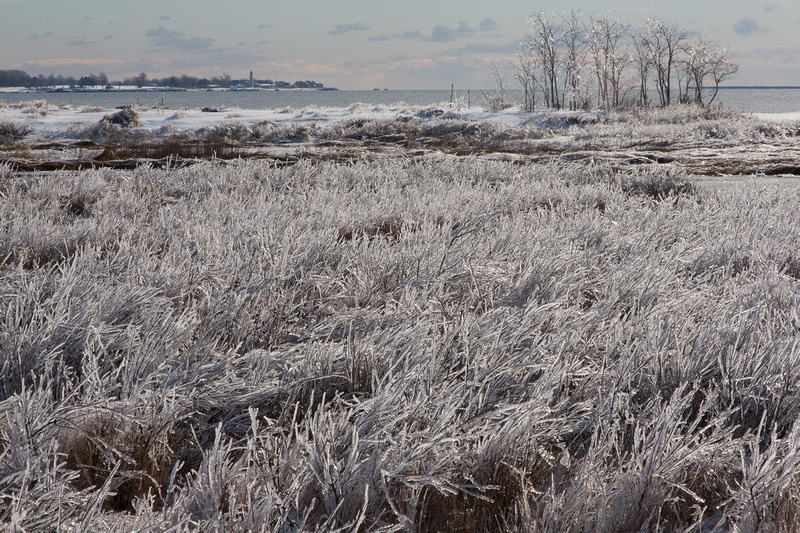

I headed to Sandy Point, in West Haven, where a Snowy Owl had been seen a few days earlier, hoping I might get to photograph one in the amazing ice show. I drove into the unplowed parking lot and my car barely cracked the crusty surface of the snow. I scanned the sparkling seascape with my binoculars, but didn't see any owls. I took a few scenic shots and decided to walk out to the point. The icy surface was a bit treacherous to walk on in places, as this picture of another walker demonstrated.
Walking along the beach, I saw plenty of gulls, Brant in New Haven Harbor and a few smaller birds darting around in the ice covered dune vegetation. A small flock of Horned Larks were feeding on the few uncovered seed heads.


A few sparrows including Song Sparrows and a pair of Ipswich Sparrows (one pictured below) also darted around the frozen weeds.
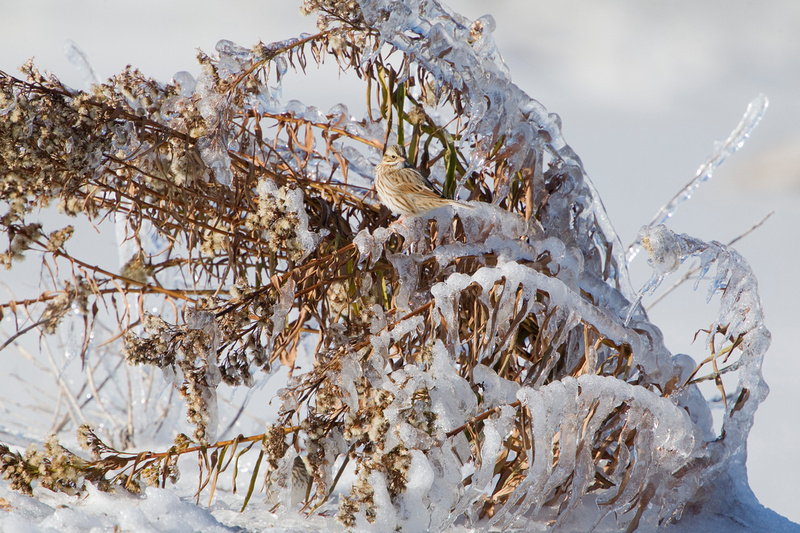

I walked well out on the point, but saw no owls. I ended up taking a lot of pictures of the glasslike, ice encrusted grasses.
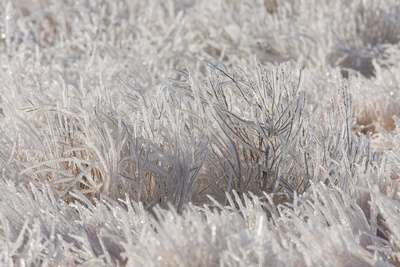





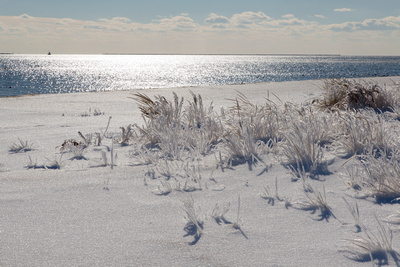

On the walk back to the parking lot another small bird popped briefly out of the grass. I couldn't identify it right away, so I followed it back down the beach a way, before it reappeared and revealed itself to be a late Palm Warbler.
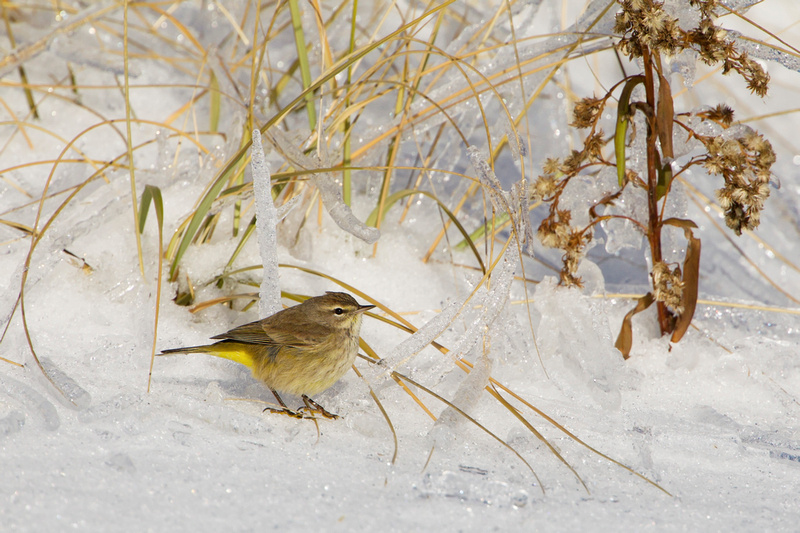

I ended up spending half the day there so Stratford would have to wait for another day. A day later a pair of Rough-legged Hawks were spotted at Hammonasset Beach State Park, and I was able to see them a couple days later. I was hoping to get pictures of the dark phase, since I don't have any, but I only saw it at quite a distance. The light phase hawk also spent most of the time hunting well out in the marsh, often across the Hammonasset River. When I arrived first thing in the morning, however, it made a few passes along the edge of Willards Island allowing me a few photographs as it hovered, almost stationary, in the brisk wind, using its tail as a rudder.


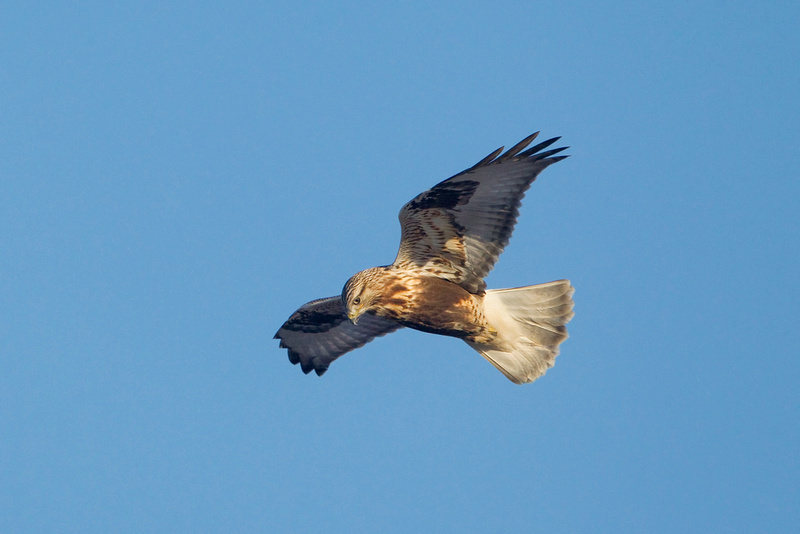

Just before Christmas I finally made it down to Stratford, stopping at Long Beach, where a number of Snowy Owls were being seen. As I was setting up my camera, a birder told me about a Glaucous Gull on the nearest breakwater. I took a few shots of it and started looking down the beach, where a Snowy Owl sat on the sand near the dunes just before the second jetty. I watched as a number of people walked past it along the waterline without disturbing it, so I started walking along the same path towards it, moving slowly and not looking directly at it. As I got closer the owl started to look alarmed so I stopped walking. It continued looking spooked so I looked behind me and saw a couple walking two large dogs along the dune line, directly towards the owl. It flew up and away, then banked and flew back toward me, gliding right over my head. I took a number of pictures of the flight but didn't have high hopes for them as I had a 2X teleconverter mounted on my 500mm lens, which I was hand holding (not the ideal setup for sharp photos!). Compounding the problem, the owl looked terrible, covered in mud on the belly, tail and wings.
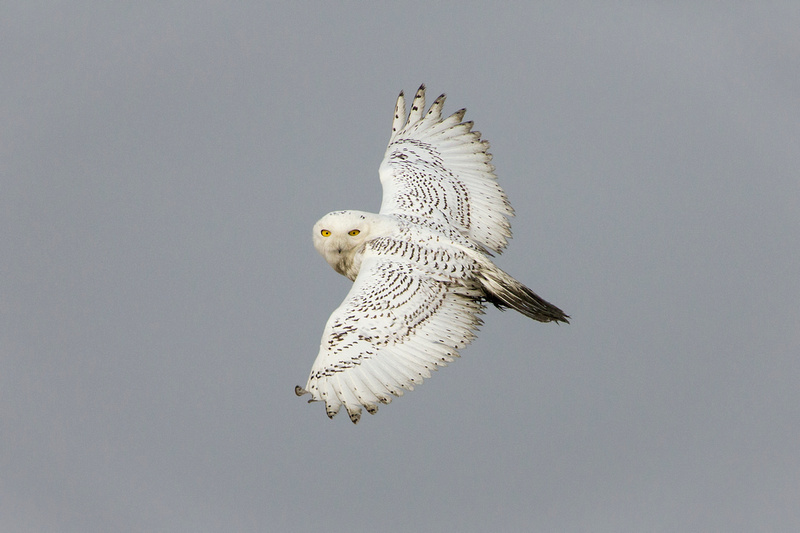

Surprisingly, I got a whole sequence of sharp photos of the owl ....
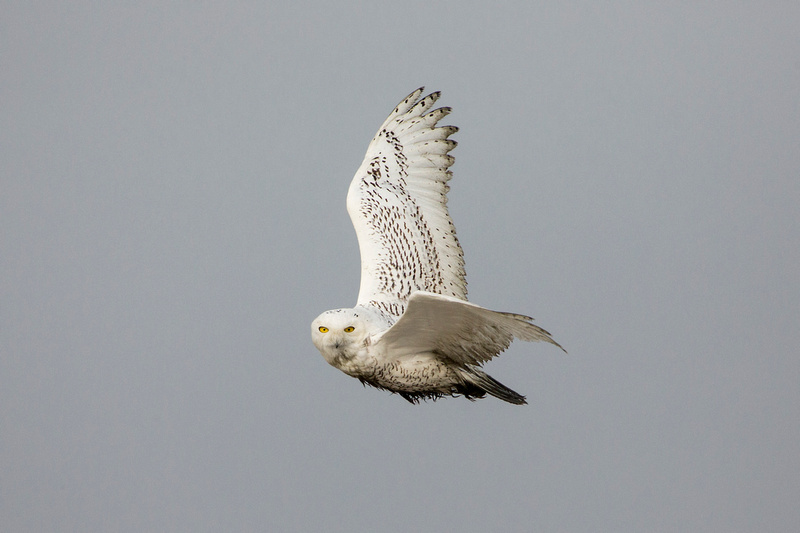

........ making the poor bird's tattered condition even more lamentable. I continued out on the beach where a photographer friend was shooting a second owl. This owl was cleaner looking and sitting up in a tree, although the clouds and fog made for a difficult photo situation. Occasionally, the sun would break through and light up the scene acceptably.


As the clouds thickened, we headed back to the parking lot to go get lunch. As we were leaving we saw the dirty owl sitting on a fence surrounded by people photographing it from all angles. The owl looked uneasy, but did not fly off. It appeared that something was wrong with it.
We went for lunch and returned to find the owl gone. We later found out that someone had called a rehabilitator who was able to pick the owl up and take it in for treatment. To end the day we went back to the first jetty to photograph the second cycle "Glaucous Gull". After I looked at the few shots I took first thing, I decided it was an Iceland Gull, not a Glaucous. When we returned to it, we both thought it was a Glaucous Gull again despite the gray wing tips, based on size, head and bill shape and behavior. It turns out that this is the infamous gull that has been stirring debate among birders and gull experts for the past two winters. There's still no consensus on the gull's identity, but the prevailing thought is that it's a very large "Kumlien's" Iceland Gull. I have no expert opinion to add, only a few more pictures.
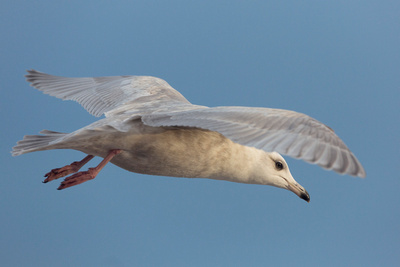

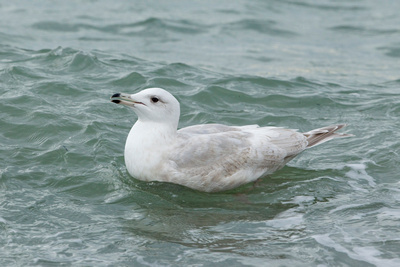





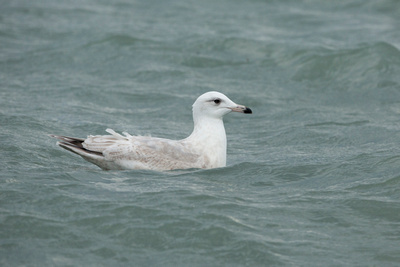

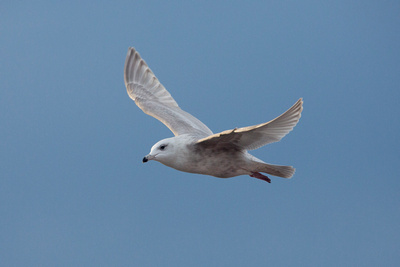

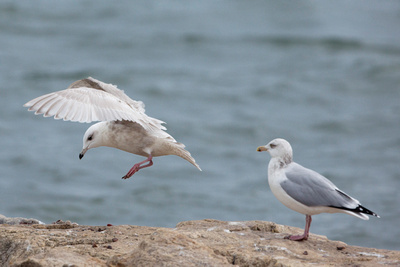

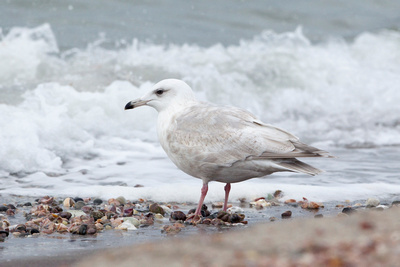

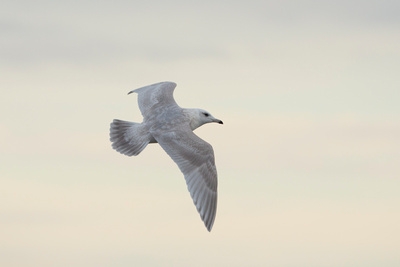

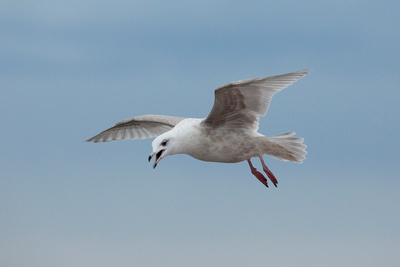

The end of the year was pretty quiet, but there was a large flock of Starlings around at Hammonasset that I spent some time photographing. I marveled as the flock swirled through the west end of the park, changing directions on a dime in unison.


At one point they wheeled around in tight horizontal swirls, known as murmurations, before I noticed a Red-tailed Hawk flying west in the middle of the flock. The behavior is a defensive mechanism to confuse birds of prey with overwhelming numbers.
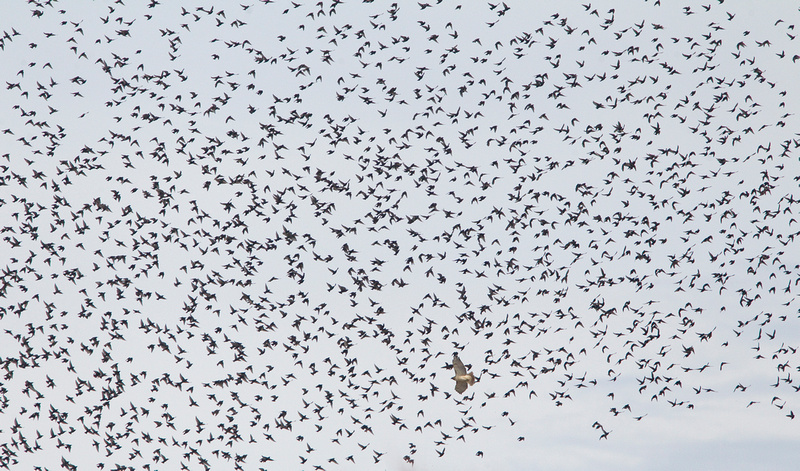

I was reviewing those pictures in the camera back and when I looked up the Starlings convulsed into a vertical comma shape. I quickly aimed the camera at the distant shape and fired off a number of frames. When I stopped shooting they were again in a long line spread out horizontally. As I reviewed these pictures discovered the cause of the gyrations, a stooping attack from above by a Peregrine Falcon that I had not even seen.


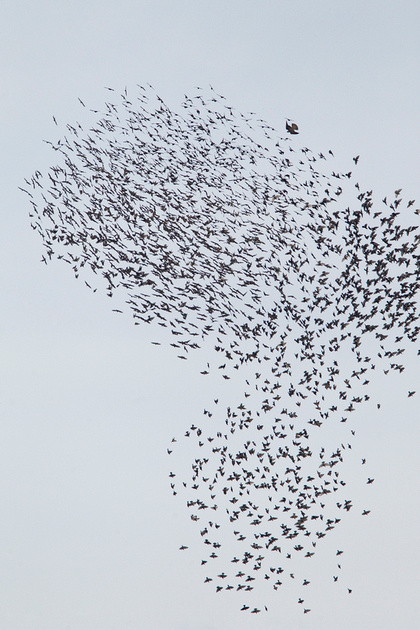

Even common and unpopular birds like Starlings can make interesting subjects. As I wrap up 2013, I look back on the many exciting observations throughout the year. It kicked off with Crossbills and Razorbills last January and ended with a spectacular South American Fork-tailed Flycatcher and the biggest movement of Snowy Owls into New England in decades. Along the way, there were plenty of great opportunities to photograph birds, from the ordinary to the exotic, that made this venture worthwhile. I'm not disappointed that I didn't see anywhere near the number of different birds that I'd hoped to. For me, it's more about quality than quantity. It's a lot more satisfying to see and photograph birds up close, even the common ones, than to compile a big list. I'll continue to work on seeing more uncommon birds, and will continue this journal on a regular basis, writing about field observations and photography. Thanks to all who followed my blog this past year.
